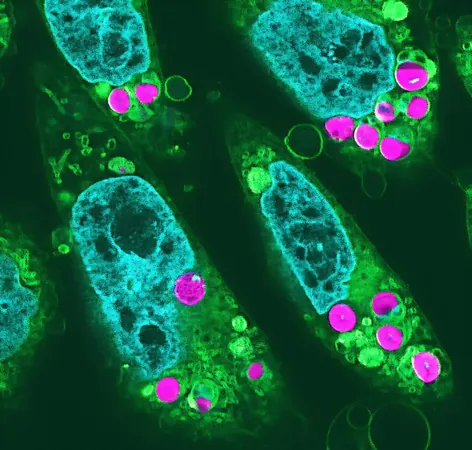
Animal Cells Achieve Photosynthesis: A Scientific Breakthrough that Could Change Everything!
2024-11-09
Author: Kai
Understanding Photosynthesis: Nature's Miracle
Photosynthesis is the process exclusive to plants, algae, and some bacteria, wherein sunlight, water, and carbon dioxide are utilized to create oxygen and sugars—essentially feeding the organism. In plants, chlorophyll, the green pigment found in leaves, absorbs sunlight and transforms it into energy. This energy allows plants to convert carbon dioxide from the atmosphere and water from the soil into glucose, a vital sugar that fuels growth. The oxygen released as a byproduct is crucial for the survival of nearly all living organisms, including humans.
Turning Animals into Miniature Oxygen Factories
Professor Matsunaga stated, "All living organisms on Earth, including humans, are able to live thanks to photosynthesis." By integrating photosynthetic properties into animal cells, scientists aim to create cells that consume less oxygen and emit less carbon dioxide, effectively turning them into miniature oxygen producers.
Despite previous endeavors dating back to the 1970s, the challenge of convincing animal cells to accept chloroplasts—where photosynthesis occurs in plants—had eluded researchers for decades. In fact, animal cells typically reject chloroplasts as foreign invaders, much like how they would react to bacteria or viruses.
A Revolutionary Approach: Feeding Animal Cells Chloroplasts
Matsunaga's team made significant progress by taking a unique approach. They first searched for chloroplasts that could thrive in the warmer environment of animal cells, which are usually cultured at approximately 37 degrees Celsius. After identifying suitable chloroplasts, they found a way to prevent the cells from recognizing them as foreign entities.
By allowing the animal cells to ingest chloroplasts as if they were food, the researchers successfully bypassed the immune response that usually destroys these organelles. Remarkably, the initial reactions of photosynthesis were detected within just two days of ingestion.
Unexpected Benefits: Increased Growth Rates
The results of this approach astonished Matsunaga and his colleagues. Not only did the animal cells tolerate the chloroplasts, but they also exhibited an increased growth rate, indicating that the chloroplasts provided an additional energy source. "I was surprised because we achieved something that had not been done for 50 years, which many in the field had considered impossible," Matsunaga remarked.
Applications for a Healthier Future
While the idea of human photosynthesis remains a distant goal, the immediate applications of this breakthrough are promising, especially in medical research and the production of lab-grown meat. One of the main challenges in growing tissues for medical applications or artificial meat lies in ensuring efficient oxygen delivery to densely packed cells. Matsunaga explained that when cells accumulate in layers, the inner layers often do not receive adequate oxygen, stalling cell division and growth.
By embedding chloroplasts in these cell clusters, scientists can enable the cells to generate their own oxygen when exposed to light, potentially allowing cell division and growth to resume. The possibilities stretch even further—Matsunaga envisions future medical applications where oxygen delivery could be enhanced by implanting LEDs to provide light to photosynthetic cells surrounding specific organs like the heart.
Towards a New Era in Biological Engineering
While extending the lifespan of chloroplasts in animal cells poses ongoing challenges, Matsunaga’s research marks a revolutionary shift in biological engineering. The potential applications of engineered photosynthetic animal cells are vast, ranging from advances in lab-grown meat to innovative medical therapies.
This breakthrough not only challenges long-standing beliefs in biology but also demonstrates the transformative potential of photosynthesis beyond plant life. With ongoing research and improvements, this pioneering work may one day contribute significantly to addressing global challenges in food production, health, and perhaps even climate change.
This remarkable study has been published in the journal *Proceedings of the Japan Academy, Series B*, setting the stage for further innovations in science.

 Brasil (PT)
Brasil (PT)
 Canada (EN)
Canada (EN)
 Chile (ES)
Chile (ES)
 España (ES)
España (ES)
 France (FR)
France (FR)
 Hong Kong (EN)
Hong Kong (EN)
 Italia (IT)
Italia (IT)
 日本 (JA)
日本 (JA)
 Magyarország (HU)
Magyarország (HU)
 Norge (NO)
Norge (NO)
 Polska (PL)
Polska (PL)
 Schweiz (DE)
Schweiz (DE)
 Singapore (EN)
Singapore (EN)
 Sverige (SV)
Sverige (SV)
 Suomi (FI)
Suomi (FI)
 Türkiye (TR)
Türkiye (TR)